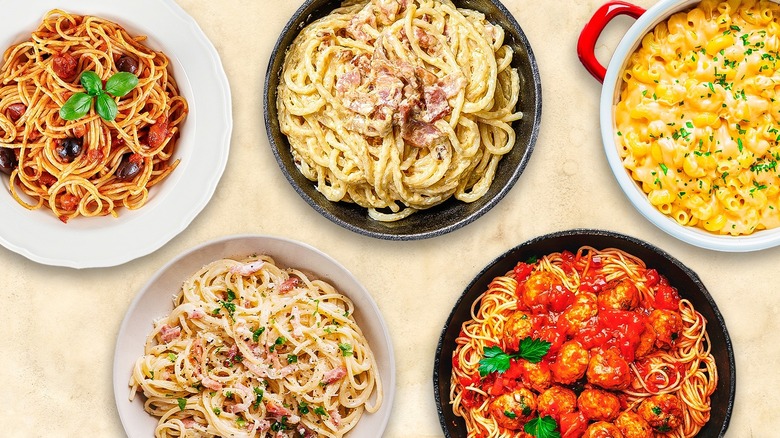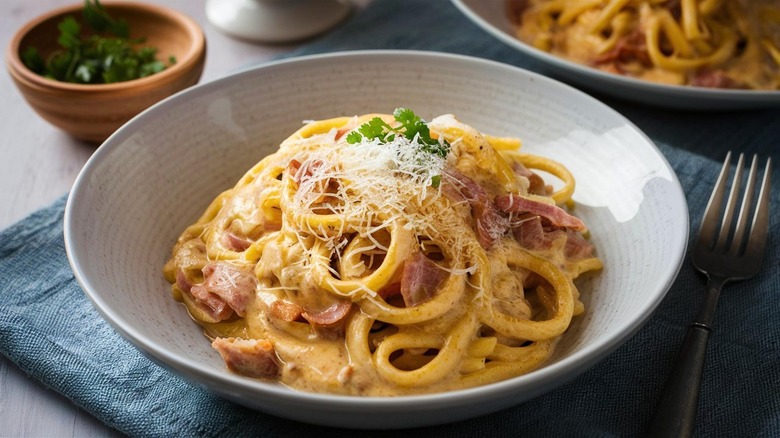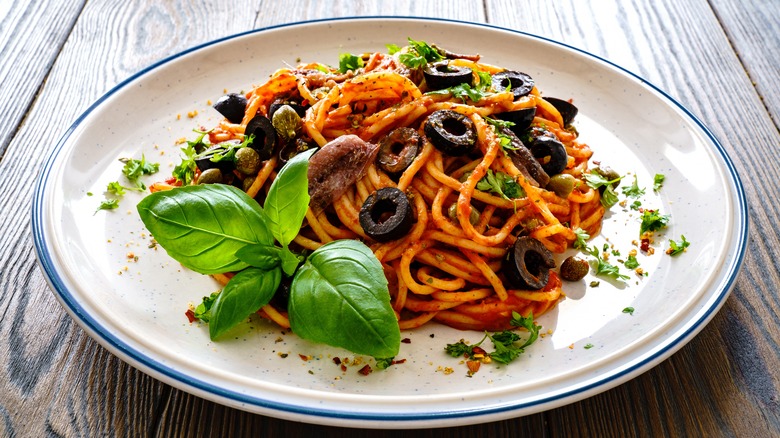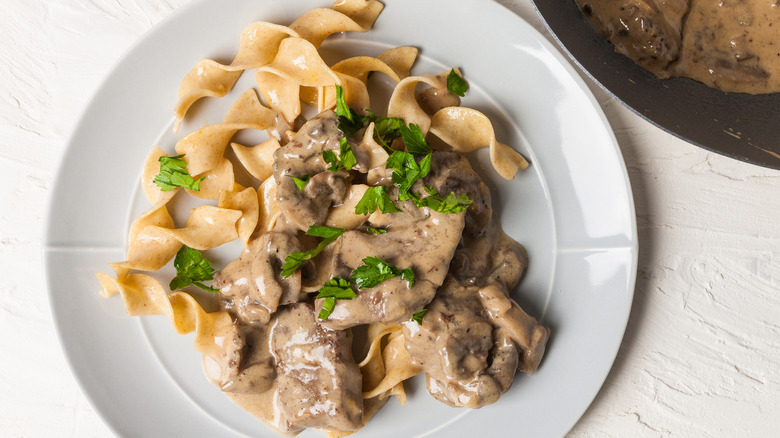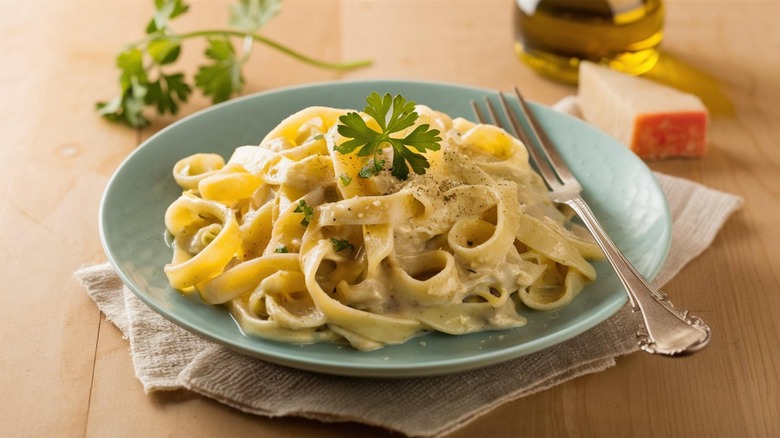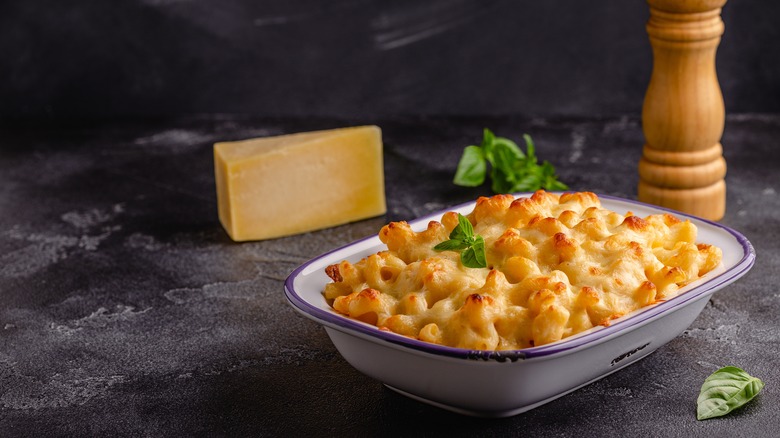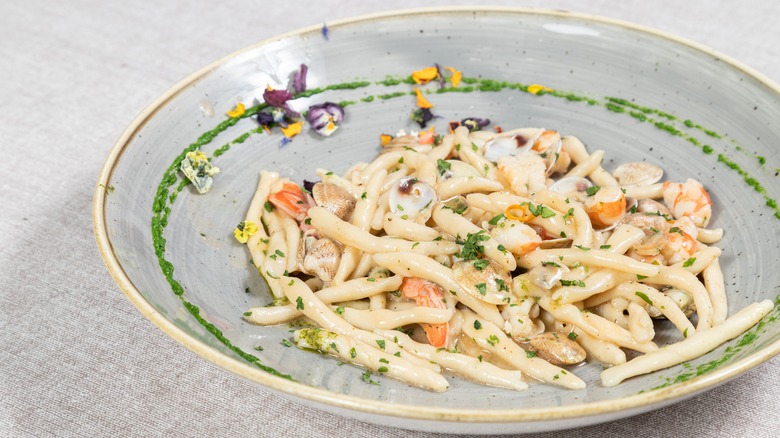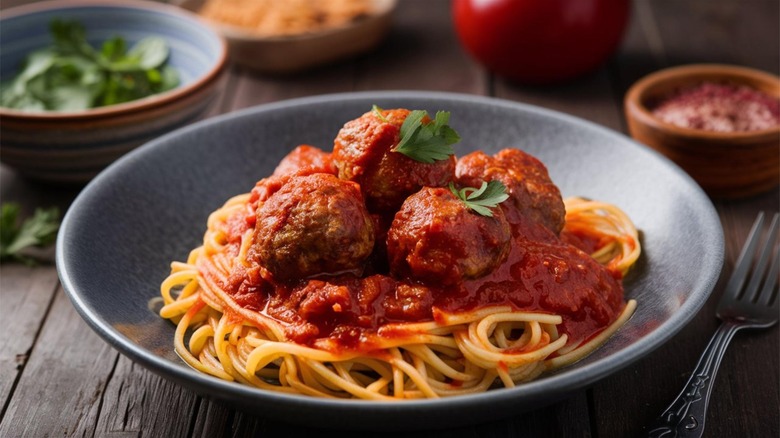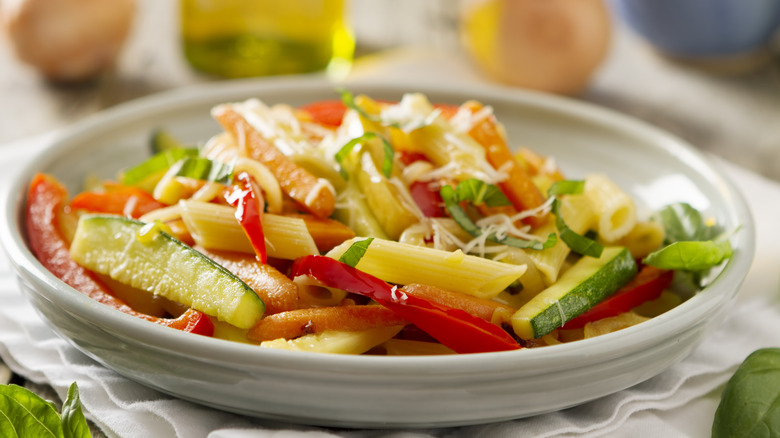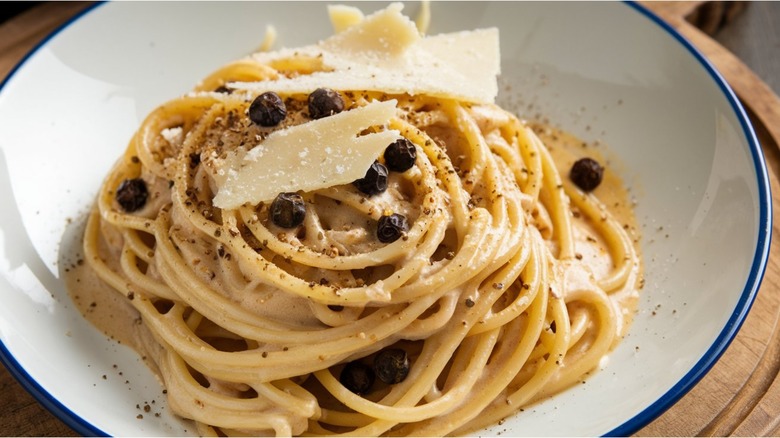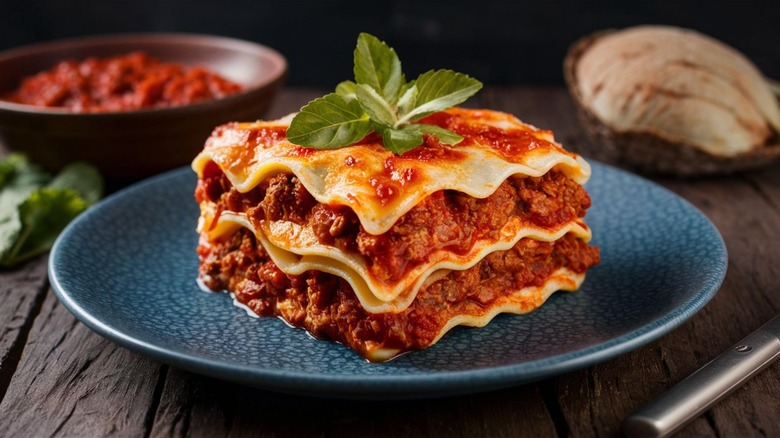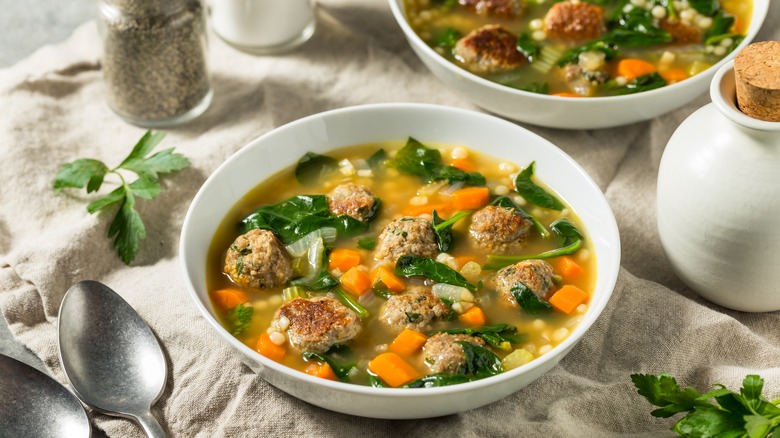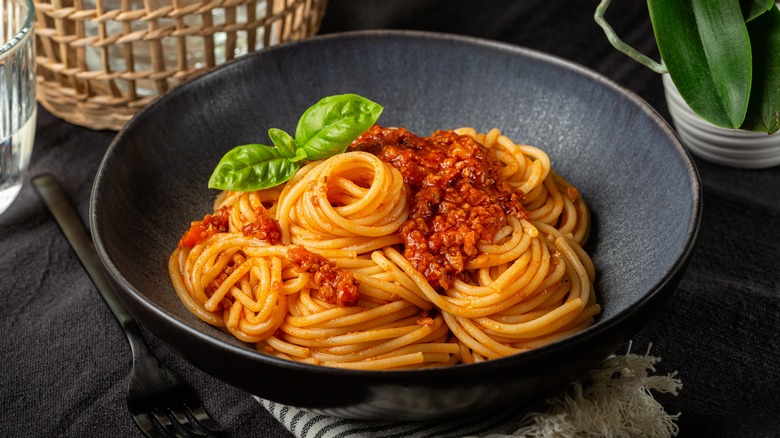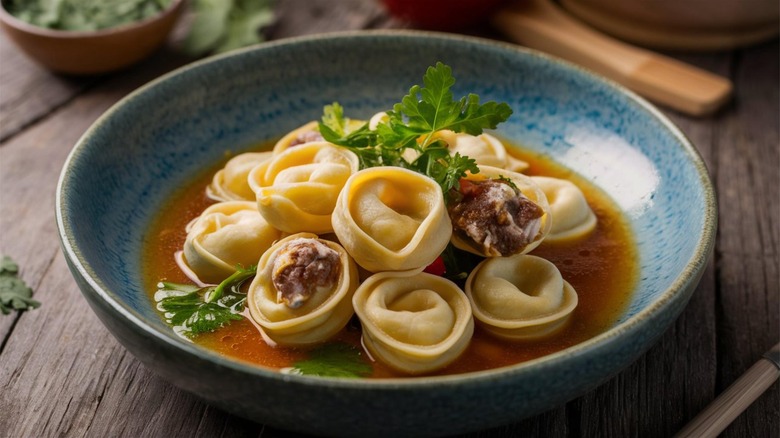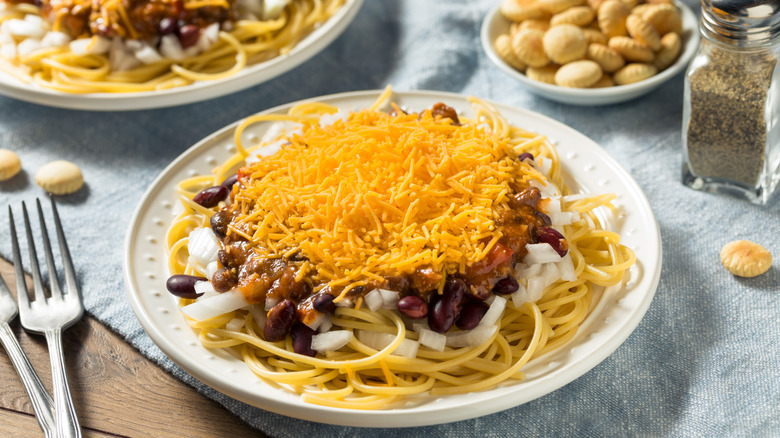14 Pasta Dishes With Fascinating Origin Stories
Few foods have such universal appeal as pasta. Historians believe the Chinese were making pasta as far back as 3,500 years ago, and that it spread from Asia to Europe, Africa, and the Middle East. Now you can find pasta on pretty much every continent and a vast array of recipes, including many that have become iconic dishes. Some of the classic pasta dishes we know and love have intriguing creation stories that go above and beyond someone simply combining pasta with sauce and other tasty ingredients.
Have you ever wondered how certain pastas got their name or how they came to be? For example, why does pasta alla puttanesca translate to "prostitute-style pasta" and what does the Stroganoff mean in beef Stroganoff? Is mac and cheese as all-American as we make it out to be, and was Italian wedding soup really created specifically for weddings? These are just a few of the questions we set out to answer. By delving into the origin stories of popular pasta dishes, we discovered some fascinating facts that might surprise you.
Carbonara
Nothing says comfort food like a bowl of carbonara pasta. A classic carbonara recipe includes only a few ingredients: pasta, raw eggs, guanciale (cured pork cheek), Pecorino or Parmesan cheese, salt, and black pepper. The dish is often connected to Rome and the Lazio region in Italy, but the true origins of carbonara are hotly debated. There are several theories as to how this creamy, cheesy, pork-flecked pasta dish came to be.
According to La Cucina Italiana, carbonara comes from the Italian word "carbonaro," which translates to "charcoal burner." This has caused many to speculate that the dish may have been invented by Italian charcoal workers. Others say the dish was created by American soldiers stationed in Italy at the end of World War II. The story suggests that the soldiers combined their rations of bacon and eggs with Italian cheese and pasta. Some also say that pasta carbonara could be an adaptation of a dish called pasta cacio e uova, which contains pasta tossed with eggs, cheese, and lard.
Puttanesca
If you're looking for a quick and easy way to jazz up store-bought tomato sauce for a pasta dish, puttanesca is a good way to go. This vibrant dish consists of pasta tossed in a sauce made with tomatoes, garlic, olives, capers, chili flakes, and fresh herbs like parsley and oregano. Some versions also include anchovies. It's fragrant and packed with briney, spicy, umami flavors. Just know though that some believe this pasta dish has a racy past. Pasta puttanesca translates loosely to "in the style of prostitutes."
Most historians agree that pasta alla puttanesca was born in Naples and became popular around the 1960s. This reason for the name is up for debate though. Some believe the dish was invented in brothels as a quick and easy meal the ladies could eat in between clients. Another theory is that a man named Sandro Petti created the dish for hungry friends who implored him to throw together any old "puttanata," which is an Italian curse word. According to Gambero Rossi, Petti changed the name to puttanesca to make it slightly less vulgar.
Beef Stroganoff
Meaty, creamy, and delicious, beef Stroganoff is the perfect meal for a cold winter night. A typical beef Stroganoff recipe includes strips of sauteed steak, onions, and mushrooms in a sour cream-based sauce. Fancy additions could include cognac, Worcestershire sauce, and Dijon mustard. The stew-like Stroganoff is often served on mashed potatoes, rice, or egg noodles. It's a Russian dish that was named after the aristocratic Stroganoff family. However, people are divided on which Stroganoff family member the dish should be attributed to.
The theory that many people find the most plausible is that beef Stroganoff was created for Count Alexander Grigorievich Stroganoff. During the 19th century, the Count would invite people to "open table" dinners at his home in Odessa. Many believe his chef created beef Stroganoff because it was easy to make, appealed to many palates, and was easy to portion out. Another popular story is that an elder Stroganoff had trouble chewing, so his chef created beef Stroganoff because it was easier on the Count's teeth than a larger, tougher piece of meat. Some also say that the dish has French influences thanks to the French chefs who worked for the Stroganoff family.
Fettuccine Alfredo
It's easy to see why fettuccine Alfredo is a staple at so many Italian restaurants. This creamy pasta dish is so simple to make, but utterly decadent. A classic fettuccine Alfredo features fresh fettuccine noodles tossed with butter and Parmigiano Reggiano cheese. Common variations include the addition of cream, parsley, veggies like mushrooms, and protein like chicken. Many will tell you though that there is only one place to get a truly authentic fettuccine Alfredo and that's at its birthplace in Rome.
The creator of fettuccine Alfredo was a Roman chef named Alfredo Di Lelio. In 1914, his wife had just given birth to their son and was feeling weak. He wanted to give her something hearty but easy to eat, so he whipped up the buttery, cheesy pasta dish. She loved it so much that he decided to put it on the menu. When Hollywood stars Mary Pickford and Douglas Fairbanks tried the dish while in Rome on holiday, they were so impressed that they spread the word about fettucine Alfredo and the dish took off in the States. You can try the original version at Ristorante Alfredo alla Scrofa where it was created or Il Vero Alfredo, which is owned by Di Lelio's family.
Mac and cheese
When you think of classic American comfort food dishes, macaroni and cheese probably comes to mind. You may have grown up eating boxed mac and cheese made with fluorescent orange powdered cheese. Or if you were lucky, perhaps someone in your family made it from scratch with real cheese, butter, and milk. It's a staple at potlucks, celebrations, and barbecues and a dish that invokes fond memories of childhood meals and family gatherings for many people. But how American is mac and cheese really?
Italians have been combining pasta and cheese for centuries, so it may not be surprising that one of the first recipes for mac and cheese comes from a 13th-century Italian cookbook. How it made its way to America is the more interesting part. In 1784, Thomas Jefferson was appointed Minister to France and brought his enslaved chef James Hemings to Paris with him. While in Europe, Jefferson fell in love with macaroni and cheese, so Hemings learned to master the dish and brought the recipe back to the United States. When dried pasta and processed cheese entered the picture at the beginning of the 20th century, mac and cheese exploded in popularity.
Strozzapreti
Most chefs will tell you that there is a world of difference between machine and handmade pasta. Pasta made by hand tends to taste fresher and has a better texture for soaking up sauce. If you're looking for an easy type of pasta to make by hand, strozzapreti should be on your radar. All you need to do is roll out your pasta dough, cut it into strips, and twist up the strips. The twisted pasta is perfect for dousing with cream sauce, tossing with meat and veggies, or smothering with ragu. Based on the name, it can also be used for something more sinister.
Strozzapreti, also called strangolapreti, translates to "priest choker" or "priest strangler." There are a few different theories as to why this pasta has such a dark name. One is that Catholic priests in the Emilia Romagna region of Italy were known for being greedy and tyrannical. In response, angry housewives created this twisted pasta and cursed it, wishing death on any priests who would eat it. Some say the twisting motion of making the pasta represents strangling the priests. Others say the pasta simply looks like the collars priests wear.
Spaghetti and meatballs
For many people, there's nothing more Italian than spaghetti and meatballs. The dish has classic Italian components like pasta, tomato sauce, meat, and Parmesan cheese. However, you might be shocked to know that spaghetti and meatballs is just one of many "Italian" foods that aren't Italian at all. This rustic dish was actually created in the United States. While it's become a wildly popular dish worldwide, it's not very common in Italy except at some restaurants that cater to tourists.
That's not to say that Italians don't eat meatballs or spaghetti with tomato sauce. They just don't typically combine the two. Meatballs are called polpette in Italy and they can be made with anything from beef to turkey and fish. They're often eaten on their own or with a salad on the side. Spaghetti and meatballs came about because the dish combined ingredients that Italian immigrants in 19th and 20th-century America had easy access to and were affordable, namely ground meat, canned tomato sauce, and dried pasta.
Pasta primavera
Pasta primavera certainly sounds Italian. Primavera means "spring" in Italian, which is a nod to the spring vegetables in the dish like peas, zucchini, and asparagus. The vegetables are tossed with butter, cream, and cheese for a luscious sauce that pulls everything together. It's colorful, creamy, and has a nice crunch from the veggies and a smattering of pine nuts. One thing it is not though is Italian. Pasta primavera was created in Nova Scotia, Canada.
Legend has it that chefs Sirrio Maccioni and Jean Vergnes of Le Cirque restaurant in New York were vacationing at an estate in Nova Scotia with food writers for the New York Times. One day they put together a meal with leftovers they found in the fridge. They called the dish spaghetti primavera and it was a hit. Vergnes didn't want to put the dish on the menu at Le Cirque, so Maccioni included it as a special. That created a huge buzz, and soon the dish was majorly trending. Craig Claiborne of the New York Times even called it, "By far, the most talked-about dish in Manhattan."
Cacio e pepe
Sometimes it's the simple dishes that have the biggest impact and endure the longest. That's the case with cacio e pepe, a supremely tasty pasta that utilizes just three ingredients. It's basically just thin pasta like spaghetti tossed with Pecorino cheese and black pepper. A splash of leftover pasta water helps give the pasta a creamy consistency. It's a classic Roman dish that's steeped in history.
Cacio e pepe, which translates to "cheese and pepper," was a staple for ancient shepherds in the Apennine Mountains of Italy. When the shepherds were on the move herding livestock, they needed food that would last a long time, keep them warm, and give them a calorie boost. The answer was dried pasta, hard Pecorino cheese, and black pepper. La Cucina Italiana reported that the pasta later became a staple in Roman taverns because the dryness of the pasta encouraged people to drink more.
There are many variations of cacio e pepe. Some people use bucatini or other types of long noodles. Some add olive oil or butter to the dish to prevent it from sticking together. However, purists will tell you that less is more when it comes to this time-tested favorite.
Lasagna
It's easy to see why so many people love lasagna. This iconic Italian dish features tender pasta noodles layered with hearty meat sauce (or veggies for the non-meat eaters) and gooey cheese. Baked until bubbling and golden on top, the dish offers a beautiful mix of textures and flavors. Another thing people love about lasagna is how versatile it is. From its early days in Greece — yes, you read that right — it's undergone countless iterations and can still be prepared in a myriad of ways to this day.
Like several of the pasta dishes on this list, lasagna didn't originate in the country you probably think it did. It was likely inspired by a Greek dish named laganon, which included sheets of pasta dough layered with other ingredients like fish. The ancient Romans brought this cooking technique back to Italy where it became lasagne. Depending on where you are in Italy, you'll find the dish made differently. For example, in Bologna, the dish typically includes bechamel sauce, while southern Italians often make it with cheeses like ricotta and mozzarella. With that in mind, you don't have to worry too much about making mistakes with lasagna. Instead, you can have fun with it and add your own unique twists.
Italian wedding soup
With a name like Italian wedding soup, you might think the dish originated out of the desire to create a decadent meal worthy of a joyous celebration. The truth is the soup started out more as a rustic peasant meal than an elaborate matrimonial dish. The version that you may be familiar with in the United States with meatballs, pasta, spinach, Parmesan, and herbs in a herbaceous broth isn't exactly what the dish looked like when it was first created. And it wasn't named for a wedding ceremony between two people.
The Italian name for the soup is minestra maritata, which translates to "married soup." However, the name pertains to the marriage of veggies and meat. According to America Domani, it originated in southern Italy around the 15th century and it was originally a winter dish made with tough vegetables that grow year-round and scraps of meat left over from the annual pig slaughter. The broth was typically made with pork bones boiled down. When Italian immigrants made their way to the United States, they adapted the dish with ingredients that were readily available like ground beef, spinach, and pasta.
Spaghetti bolognese
When many people want a comforting and familiar Italian pasta, they turn to spaghetti bolognese. A traditional "spag bol" usually features diced onions, carrots, and celery simmered in a savory tomato sauce with ground beef or pork. Some people jazz it up with ingredients like bacon, oregano, and cream. It's a dish that is widely considered an Italian classic, but one that you won't find on many menus in Italy. That's because the sauce is actually called ragu alla Bolognese and it's rarely served with spaghetti.
The first records of ragu alla Bolognese can be traced back to a man named Alberto Alvisi who was the chef for the Cardinal of Imola in the 18th century. While the dish has been tweaked over the centuries, many agree that certain elements make the dish a classic and must be adhered to. The Accademia Italiana della Cucina says it must be made with ground beef, pancetta, tomatoes, carrots, celery, onions, and wine. You can enhance it with chicken livers or porcini mushrooms, but bacon and garlic are absolute nos. And many will tell you it must be served on fresh tagliatelle.
Tortellini
Italy has hundreds of different types of pasta, but only one of them has an origin story that involves a peeping Tom and a goddess. The town of Castelfranco Emilia claims to be the birthplace of tortellini. Local legend says the dish was created after the goddess Venus passed through town and stayed at a local inn. The story goes that the owner of the inn spied on the goddess through the keyhole in the door and was immediately inspired to create a pasta dish shaped like the goddess' naval.
Whether or not you believe the origin story of tortellini, the truth is this pasta dish can be pretty divine. Flat egg noodles are rolled out until thin, cut into squares, and topped with fillings that often include meat and cheese. The pasta is then folded around the fillings to make circular parcels. In the Emilia-Romagna region where tortellini has been eaten since the 12th century, the pasta is typically served in broth. However, you can also find tortellini fried in butter and served with sauce. There are even sweet tortellini filled with cream and dusted with sugar.
Cincinnati chili
To outsiders who aren't from Cincinnati, the concept of adding chili to pasta and topping it with beans, onions, and cheese might seem a bit odd. However, locals are fiercely proud of the dish and consider it as worthy of recognition as Chicago-style hot dogs or hoagies. Like those iconic regional dishes, Cincinnati chili can be traced back to enterprising immigrants who took familiar flavors from their homeland and adapted them to American tastes.
In 1920, brothers John and Tom Kiradjieff left Macedonia for the United States. Within a few years, they opened the Empress Chili Parlor. At that time, chili parlors were becoming popular throughout the United States. However, the brothers didn't serve Texas-style chili. They put their own twists on the meaty dish, using Mediterranean spices like nutmeg, clove, and cinnamon. Locals loved it and requested variations that are now commonplace such as adding chili on top of spaghetti and getting it "five-way" with spaghetti, chili, diced onions, kidney beans, and shredded cheddar cheese. Oyster crackers are optional, but highly recommended.
